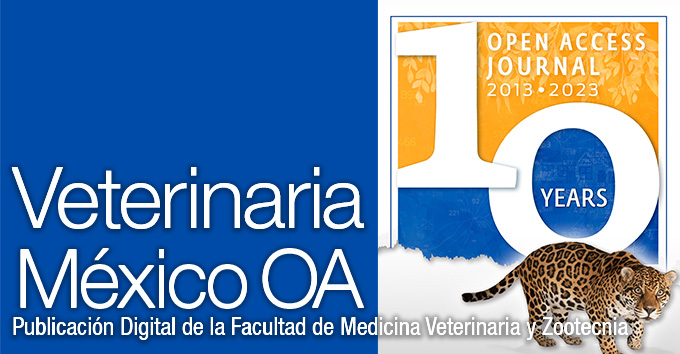Identity and frequency of non-traditional companion animals presented at a university teaching hospital: a retrospective study (2009–2019)
Main Article Content
Abstract
This study describes the diversity of the species received for medical evaluation at the Exotic Pet and Wildlife Teaching Hospital in Mexico; identifying the most common non-traditional companion animals owned, the frequency of the species received along the years, and which of those correspond to native Mexican wildlife. This retrospective descriptive study comprised 8 619 patient records from 2009 to 2019. During the period analyzed, 129 species were identified, 60 of these being native Mexican wildlife. Most of the patients received were mammals (56.36 %) followed by reptiles (38.73 %), and 4.91 % remaining were composed by birds, amphibian, fish and invertebrate species. Eight species contributed to the highest percentage of the records (79.88 %), being the red-eared slider (Trachemys scripta elegans) the most common (18.71 %). The number of annual records varied through the period with a trend for increased demand recently. It was possible to identify changes in the frequency of visits of different species over the study period, which allowed us to determine that the preference for the maintenance of some species in captivity has decreased. Commonly received species identification allows veterinary medicine students to specialize and develop the required species-specific medical competencies.
Article Details
References
Ceballos G, Arroyo-Cabrales J. Lista actualizada de los mamíferos de México. Revista Mexicana de Mastozoología (Nueva Época). 2012;2(1):27–80.doi: 10.22201/ie.20074484e.2012.2.1.20.
Flores-Villela O, Canseco-Márquez L. Nuevas especies y cambios taxonómicos para la herpetofauna de México. Acta Zoológica Mexicana. 2004;20(2):115–144. doi: 10.21829/azm.2004.2022332.
American Ornithologists’ Union. Check-list of North American birds. 6th ed. Washington, DC; 1983. 877 p.
Chitty J, German A, Kirk J. Non-traditional companion animals. BSAVA. 2022. https://www.bsava.com/position-statement/non-traditional-companion-animals/
Rayment-Dyble L. Reptile pet trade and welfare. In: S Girling, and P Raiti, editors. BSAVA Manual of Reptiles. Gloucester, UK; 2019. p. 26–35.
INEGI. Bienestar Subjetivo. 2014 [cited 2020 Nov 2]. https://www.inegi.org.mx/investigacion/bienestar/ampliado/default.html#Tabulados
INEGI. Encuesta Nacional de Bienestar Autoreportado. México; 2021. https://www.inegi.org.mx/contenidos/saladeprensa/boletines/2021/EstSociodemo/ENBIARE_2021.pdf
Martin LF. Retrospective study on the species distribution and common diseases in exotic pets presented to the Clinic for Zoo Animals, Exotic Pets and Wildlife, University of Zurich from 2005 to 2014. Zurich Open Repository and Archive. 2018;90. doi: 10.5167/uzh-166057.
Hernández GA. Características de la fauna silvestre atendida en el Hospital Veterinario de Especialidades en Fauna Silvestre y Etología Clínica de la Facultad de Medicina Veterinaria y Zootecnia de la Universidad Nacional Autónoma de México durante los años 2005-2010. UNAM; 2012. https://ru.dgb.unam.mx/handle/DGB_UNAM/TES01000685831
IUCN. The IUCN Red List of threatened species. https://www.iucnredlist.org
IBM/SPSS 25 Statistics Brief Guide. Armonk, NY; 2021.
Jyrinki H. The attitude-behaviour relations in pet-related consumption. The Roots and Fruits of the Nordic Consumer Research. 2010;119–36. http://www.uva.fi/materiaali/pdf/isbn_978-952-476-332-5.pdf#page=131
Nadal Urías L, Carmona Omana A, Trouyet Starr M. Tráfico ilegal de vida silvestre. Cuadernos de Divulgación Ambiental. 2013;(1):7.
CITES. The Cites Appendices. https://cites.org/eng/app/index.php
DOF. Ley General de Vida Silvestre. 2018. http://www.diputados.gob.mx/LeyesBiblio/pdf/146_190118.pdf
Jenkins JR. Marketing the avian and exotic practice. Seminars in Avian and Exotic Pet Medicine. 1996;5(1):17–22. doi: 10.1016/S1055-937X(96)80012-0.
Burghardt GM. Keeping reptiles and amphibians as pets: challenges and rewards. Veterinary Record. 2017;181(17):447–449. doi: 10.1136/vr.j4912.
Wills A, Holt S. Confidence of veterinary surgeons in the United Kingdom in treating and diagnosing exotic pet species. Veterinary Record. 2020;186(18):e20. doi: 10.1136/vr.105664.
AVMA. US pet ownership statistics for exotic pets. American Veterinary Medical Association. 2018 [cited 2020 Nov 4]. https://www.avma.org/resources-tools/reports-statistics/us-pet-ownership-statistics
Kanui T, Mwendia C, Aulie A, Wanyoike M. Effects of temperature on growth, food uptake and retention time of juvenile nile crocodiles (Crocodylus niloticus). Comparative Biochemistry and Physiology Part A: Physiology. 1991;99(3):453–456. doi: 10.1016/0300-9629(91)90032-8.
Dickinson HC, Fa JE. Ultraviolet light and heat source selection in captive spiny-tailed iguanas (Oplurus cuvieri). Zoo Biology. 1997;16(5):391–401.doi: 10.1002/(SICI)1098-2361(1997)16:5<391::AID-ZOO2>3.0.CO;2-5.
License

Veterinaria México OA by Facultad de Medicina Veterinaria y Zootecnia - Universidad Nacional Autónoma de México is licensed under a Creative Commons Attribution 4.0 International Licence.
Based on a work at http://www.revistas.unam.mx
- All articles in Veterinaria México OA re published under the Creative Commons Attribution 4.0 Unported (CC-BY 4.0). With this license, authors retain copyright but allow any user to share, copy, distribute, transmit, adapt and make commercial use of the work, without needing to provide additional permission as long as appropriate attribution is made to the original author or source.
- By using this license, all Veterinaria México OAarticles meet or exceed all funder and institutional requirements for being considered Open Access.
- Authors cannot use copyrighted material within their article unless that material has also been made available under a similarly liberal license.



